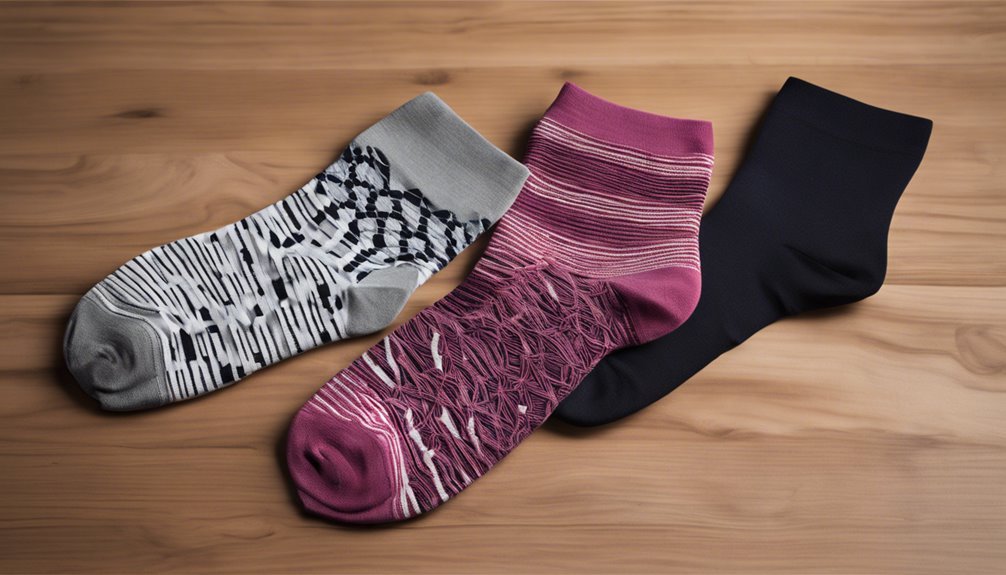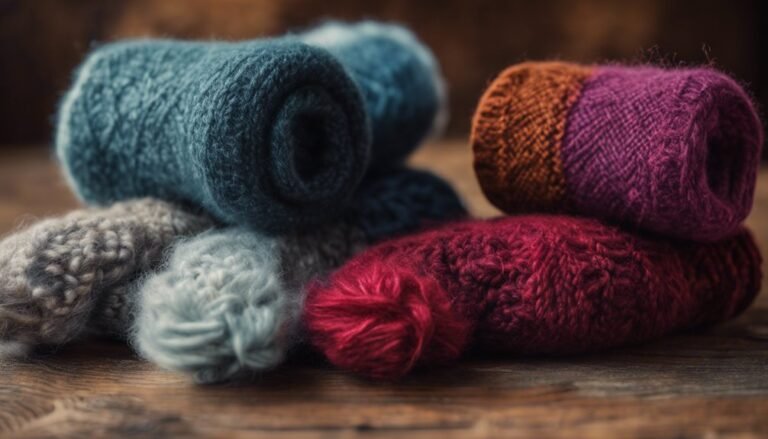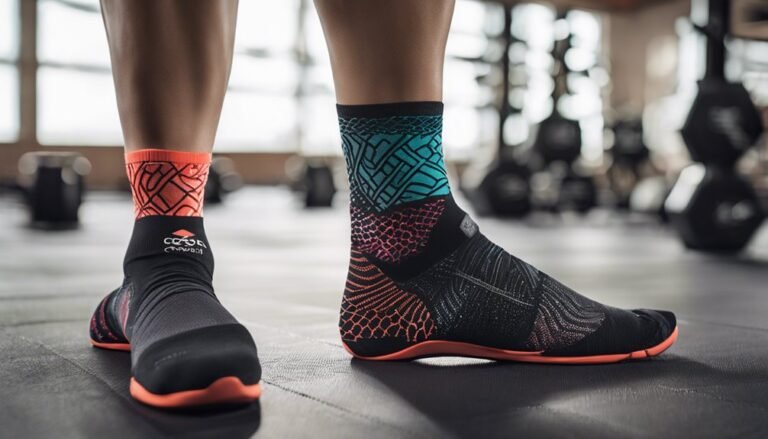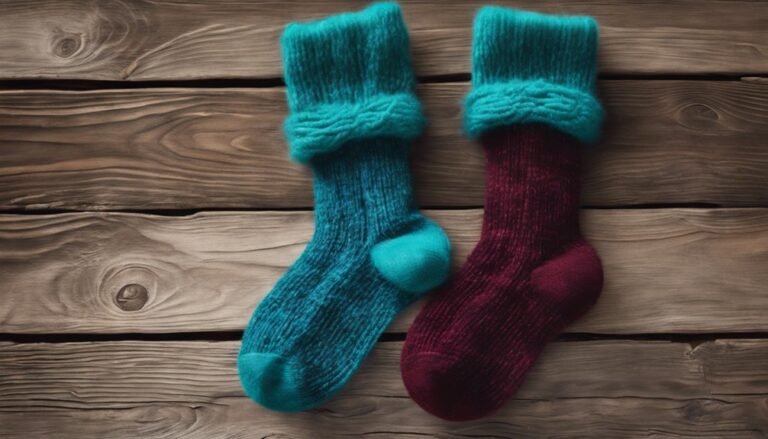Anti-Odor Socks vs. Regular Socks: Do They Really Work?
Anti-odor socks definitely work better than regular socks. They feature advanced moisture-wicking materials and antimicrobial treatments that effectively reduce odor caused by sweat and bacteria. Unlike standard cotton blends, these specialized fabrics enhance breathability and resist odor buildup. Regular socks often trap moisture, leading to unpleasant smells and discomfort. Many users report significant improvements in odor control and comfort with anti-odor options. To explore the differences further and find the best choice for your feet, keep exploring.
Understanding Foot Odor: Causes and Factors

Foot odor, a common yet often overlooked issue, stems from various biological and environmental factors. The primary causes of foot odor include excessive sweating, bacterial growth, and the breakdown of sweat. When your feet sweat, moisture accumulates, creating an ideal environment for bacteria to thrive. These bacteria break down sweat and skin cells, leading to the unpleasant smell you might notice. Contributing factors can involve the type of footwear you choose, as synthetic materials can trap moisture, worsening the odor. Additionally, personal hygiene practices and certain medical conditions, such as hyperhidrosis, can exacerbate the issue. Understanding these causes and factors can empower you to address foot odor effectively, allowing you to enjoy greater freedom in your daily activities.
What Are Anti-Odor Socks?
Anti-odor socks are specially designed garments that combat foot odor through advanced materials and technology. These socks utilize innovative sock materials to enhance odor management, providing a more comfortable experience throughout the day.
| Feature | Anti-Odor Socks | Regular Socks |
|---|---|---|
| Material | Moisture-wicking fabrics | Cotton or blends |
| Odor Control | Embedded antimicrobial agents | Minimal to none |
| Durability | Enhanced for longevity | Standard wear |
The Science Behind Anti-Odor Technologies
When you choose anti-odor socks, you're benefiting from advanced materials designed to resist odor buildup. These socks often incorporate antimicrobial treatments that inhibit the growth of bacteria, which are primarily responsible for unpleasant smells. Additionally, moisture-wicking technologies play an essential role in keeping your feet dry, further reducing the potential for odors to develop.
Odor-Resistant Materials Explained
While traditional socks may trap moisture and bacteria, leading to unpleasant odors, odor-resistant materials employ advanced technologies to combat these issues effectively. These socks often feature a blend of natural fibers and synthetic blends, optimizing odor absorption and fabric breathability. The design enhances moisture management, keeping your feet dry and comfortable. Durability factors are also vital; high-quality materials resist wear and maintain performance over time. Additionally, temperature regulation is a key feature, ensuring your feet stay cool or warm as needed. When considering your choices, it is important to assess the environmental impact of these materials, as some synthetic blends may pose sustainability concerns. Overall, these innovations offer freedom from odor while enhancing your daily comfort.
Antimicrobial Treatments Overview
Advanced odor-resistant materials often incorporate antimicrobial treatments to enhance their effectiveness against odor-causing bacteria. These antimicrobial agents—such as silver ions, copper, and zinc—work by disrupting the cellular processes of bacteria, thereby reducing their ability to multiply and produce odor. The treatment effectiveness varies based on the agent used and the application method.
| Antimicrobial Agent | Treatment Effectiveness |
|---|---|
| Silver Ions | High |
| Copper | Moderate |
| Zinc | Moderate |
| Triclosan | High |
| Chitosan | Variable |
Understanding these treatments helps you make informed choices about anti-odor socks, ensuring you enjoy a fresher experience without compromising freedom in your active lifestyle.
Moisture-Wicking Technologies Impact
Moisture-wicking technologies play an essential role in the effectiveness of anti-odor socks, as they actively manage sweat and moisture to minimize the growth of bacteria. These technologies promote moisture absorption, drawing sweat away from your skin and keeping your feet dry. By facilitating evaporation, they enhance temperature regulation, preventing overheating during physical activities. This not only increases comfort but also limits the conditions that foster microbial growth. As a result, you can experience prolonged freshness, even during extended wear. When choosing socks, consider those with advanced moisture-wicking properties, as they directly impact the performance and longevity of your footwear experience. In this way, you gain both comfort and freedom from odor.
Comparing Materials: Anti-Odor vs. Regular Socks

When evaluating the materials used in anti-odor socks versus regular socks, you'll find that the differences greatly impact performance and comfort. Anti-odor socks typically utilize advanced synthetic fabrics blended with natural fibers, enhancing both durability and breathability. In contrast, regular socks often rely on traditional cotton or polyester, which might lack the same level of moisture management.
Consider these key factors:
- Durability: Anti-odor materials can withstand more wear and tear.
- Breathability: Specialized fabrics offer superior airflow.
- Moisture Management: Enhanced wicking properties reduce odor.
- Comfort: Soft blends in anti-odor socks can feel better against the skin.
These elements are essential when determining which type of sock best suits your lifestyle and needs.
User Experiences: Testimonials and Reviews
While many users have reported varying experiences with anti-odor socks, the consensus often highlights their effectiveness in combating unpleasant smells and enhancing overall comfort. Customer feedback frequently emphasizes that these socks maintain freshness even after prolonged wear, making them ideal for active lifestyles. Users often appreciate the moisture-wicking properties, which reduce sweat accumulation and, consequently, odor. Many testimonials indicate that switching to anti-odor socks has led to a noticeable decrease in foot odor, contributing to a more pleasant experience throughout the day. However, some customers note that the effectiveness can vary based on individual foot conditions and usage patterns. Overall, user experiences suggest that anti-odor socks provide a significant advantage over regular socks for those seeking freedom from unpleasant smells.
Cost Analysis: Are Anti-Odor Socks Worth It?
Are anti-odor socks worth the investment compared to regular socks? When evaluating the cost comparison, you'll find that while anti-odor socks often have a higher upfront price, their long-term savings can make them a smart choice. Consider these factors:
- Durability: Anti-odor socks tend to last longer, reducing frequent replacements.
- Odor Control: Fewer wash cycles can save on laundry costs and detergent.
- Comfort: Enhanced materials provide better foot health, minimizing potential medical expenses.
- Performance: They can improve your overall experience, making you more active and engaged.
Ultimately, if you factor in these elements, investing in anti-odor socks may not only enhance your comfort but also lead to significant financial benefits over time.
Making the Right Choice for Your Feet

When choosing socks, it is crucial to evaluate material composition and how they perform under different conditions. Anti-odor socks often incorporate specialized fabrics designed to wick moisture and inhibit bacterial growth, while regular socks may rely on traditional materials. Understanding these differences can help you make an informed decision that suits your lifestyle and foot health needs.
Material Composition Differences
Choosing the right socks involves more than just style; it hinges on understanding material composition. Anti-odor socks often utilize advanced materials, while regular socks typically rely on traditional fabrics. Here's what to evaluate:
- Cotton Blends: Offer breathability and comfort but may retain moisture, leading to odor.
- Synthetic Fibers: Designed to wick moisture away, enhancing dryness and reducing odor buildup.
- Moisture Management: Look for materials that actively control sweat and bacteria.
- Durability: Synthetic options generally provide longer-lasting performance compared to cotton blends.
Knowing these differences empowers you to make informed choices for your feet, ensuring comfort and effectiveness. Whether you choose cotton blends or synthetic fibers, understanding these materials can greatly impact your sock experience.
Performance in Various Conditions
Understanding material composition is just the starting point; performance in various conditions can greatly influence your sock choice. If you lead an active lifestyle, consider how environmental factors like humidity, temperature, and activity level affect your feet. Anti-odor socks often excel in moisture-wicking, keeping your feet dry and minimizing odor during intense workouts. In contrast, regular socks may not provide the same level of breathability or odor control, especially in warm climates. When choosing socks, think about where you'll wear them—hiking, running, or casual outings. Ensuring your socks match the conditions of your activities can enhance comfort and performance, allowing you to focus on your freedom of movement without distraction. Make an informed choice that supports your lifestyle.
Frequently Asked Questions
Can Anti-Odor Socks Help With Sweaty Feet?
While regular socks absorb sweat, anti-odor socks utilize advanced moisture management technologies to combat sweaty feet. By enhancing foot hygiene, they can markedly reduce odor, keeping your feet fresher and more comfortable throughout the day.
How Often Should I Wash Anti-Odor Socks?
You should wash anti-odor socks regularly, preferably after every wear or every few wears, depending on your activity. Maintaining proper washing frequency guarantees peak sock care, keeping them effective and extending their lifespan.
Are There Specific Brands Recommended for Anti-Odor Effectiveness?
When considering brand comparisons for anti-odor effectiveness, check customer reviews. Popular brands often highlight advanced materials and technology. You'll find that some outperform others, so researching can lead to smarter choices and better results.
Do Anti-Odor Socks Lose Effectiveness Over Time?
Yes, anti-odor socks can lose effectiveness over time due to longevity factors like material composition. Frequent washing, wear, and the breakdown of antimicrobial treatments contribute to diminished odor control, impacting their performance in the long run.
Can I Wear Anti-Odor Socks Without Shoes?
You can wear anti-odor socks without shoes, enhancing sock comfort and promoting foot hygiene. However, prolonged exposure to moisture and dirt may reduce their effectiveness, so consider this for maintaining ideal performance and freshness.







